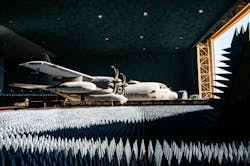ARA to provide anechoic chamber antennas for Air Force electronic warfare (EW) test and measurement
EDWARDS AIR FORCE BASE, Calif. – U.S. Air Force test and measurement experts needed antenna systems to improve electronic warfare test capability at the Benefield Anechoic Facility at Edwards Air Force Base, Calif. They found a solution from Applied Research Associates (ARA) Inc. in Albuquerque, N.M.
Officials of the Air Force Test Center's Test Range and Specialized Contracting Division at Edwards Air Force Base, Calif., announced a $20.3 million contract to ARA this week for the Benefield Anechoic Facility Antenna Systems (BAF Ants) project.
ARA will provide a 2-to-18-GHz antenna system able to change polarizations and beamwidths with a large dynamic range in its effective radiated power.
Antennas will operate in a diverse environment, beside other simulators and RF radiators. The antennas will have a predictable pattern and low reflectivity to maintain an effective presentation of signals.
EW test capabilities
The Benefield Anechoic Facility is host to electronic warfare (EW) test and evaluation capabilities like RF threat signal simulators; communications, navigation, and identification simulators; and avionics stimulators.
Systems under test are placed inside the Benefield Anechoic Facility chamber, which provides a controlled and secure test environment for simulating several signals that test items could experience in flight.
The facility transmits advanced and emerging-threat waveforms to test the electronic combat support systems of current and future aircraft and weapon systems.
ARA will perform work in computational modeling and simulation' RF design, prototyping, and fabrication; antenna pattern measurement; and antenna radar cross section measurement.
To present diverse signal angles of arrival, ARA will provide six to twelve mobile carts, each with the antennas necessary to radiate at frequencies of 2 to 18 GHz. The system will be able to change polarizations and beamwidths, and provide a large dynamic range of effective radiated power.
Antennas will be able to accept RF input from several channels simultaneously; offer variable beamwidth to accommodate testing of jet fighter and bomber aircraft; offer low-reflectivity radar cross to minimize bistatic reflections; have linear and circular polarization; and offer high-dynamic-equivalent isotropic radiated power to simulate aircraft ingress and egress.
In addition, Applied research will maintain and develop analog and digital stimulations; upgrade and maintain modeling and simulation tools like computation electromagnetics, electromagnetic propagation and attenuation; perform RF testing at remote locations; and conduct field tests onsite or at other government and contractor locations.
On this contract, ARA will do the work at Edwards Air Force Base, Calif.; and Lafayette, Colo., and should be finished by May 2030. For more information contact ARA online at www.ara.com, or the Air Force Test Center at www.aftc.af.mil/About-Us/Fact-Sheets/Article/3444224/air-force-test-center.
About the Author
John Keller
Editor-in-Chief
John Keller is the Editor-in-Chief, Military & Aerospace Electronics Magazine--provides extensive coverage and analysis of enabling electronics and optoelectronic technologies in military, space and commercial aviation applications. John has been a member of the Military & Aerospace Electronics staff since 1989 and chief editor since 1995.
